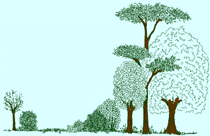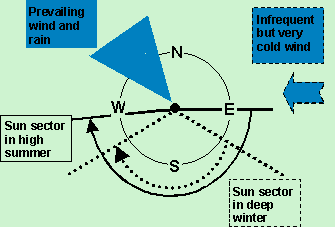 |
||
|
Sectoral analysis |
Whether
you are starting with a clean sheet, or adding to an already developed
location, you will need to create a plan of that space. On
it will be marked the location of the boundaries and any trees and other
permanent features (see Design Sequences) but there is more. You must
start to gather information about different habitats such as
areas of full sun or shade; the extent of any
slope; information on water to identify rain
shadows and free-draining or boggy areas; the direction of prevailing
wind in different seasons; what wildlife visitors
come in and whether they stay. All of these have implications for the use
of the site and feed into our successful choices on layout and design.
Much of this information can come from simple and protracted
observation. If you have the luxury of time and the patience, then
the habitat information should ideally be taken during the passage of the
four seasons. We can, however, do a lot of preparatory work
that fills in many of the gaps and starts to build a living picture of our
site. SECTORAL ANALYSISSectoral analysis is a simple tool that allows us to start looking at how the natural elements affect our site. For example, sunshine is an obvious element since where it bathes our site, and at what time of day, gives us valuable information about where we can place things. The sun rises in the E, is heighest at midday (due S) and sets in the W. The sun is later to rise in winter, is lower at midday, sets earlier and not so far W as it does in summer. Thus there are two different sectors for summer and winter sunshine. Our most productive plant growth will be in full sun but we should also learn to use our less sunny areas for plants that grow in shade. Hedges, walls and buildings all effect how light falls on our site. A hedge during summer may only cause shade on a border in early morning and late afternoon. However, in winter, the border may be in permanent shade because the sun is lower and the hedge high enough to block it out. We would put a vegetable store on a north-facing wall so that it is in shade. Sun and frost damage are connected. Plants in winter shade are less likely to suffer damage as they are able to thaw more slowly. Wind is an element that also has sectors. There will be periods of the year that may be regularly windy giving a predominant (prevailing) wind direction for our site. Wind will always affect plant growth, knocking it back, and therefore its season and direction are important in the layout of the components of our site. We may have to add windbreaks. Solid structures make the least effective windbreaks since wind is funneled up and over, creating eddies that have a greater damaging effect. Windbreaks that filter the wind are much more protective (such as a hedge or windbreak netting) and their effect can be felt at distances of up to ten times the height of the windbreak. Wind and frost are interconnected. Cold air is heavier than warm and tends to sink downwards. Windy sites have this cold air blown away, reducing the chances of plant damage. In terms of design, frost pockets tend to be areas where the denser cold air falls and collects without disturbance. If at all possible, wind should be funneled into these pockets or potential wind breaks removed or diminished. Rainfall and watercourses can also be slotted into a sector distribution. Rain may come from a predominant direction (e.g. from the W for most of us) and thus there may be water shadows in our sites caused by buildings, shrubs and trees. Conversely there will be areas where any rain will always fall on to soil and where its subsequent drainage then becomes a factor. Water and rainfall should always be used for maximum effect, and if there is a problem associated (i.e. flooding or boggy areas) then it should be turned into an advantage - tree planting markedly affects water run-off and water can be channeled through a site by diversion ditches either to storage (a pond or lake) or off site (directly into a watercourse or into land drainage). -topASPECT: ELEVATION & SLOPEFew of us have the luxury of an entirely flat site located at sea level. This dream site would have evenly distributed sunlight, rainfall and drainage, a mild climate, and may not necessarily be windswept! Our dream must end as reality probably means that we all live with bumps and hummocks, on hillsides, and with the weather as a major topic of conversation. As we will see, the determination of slope and elevation for our site complements the sector analysis. ELEVATION is critical when most of us live in a semi-upland area. The higher we are, the shorter the growing season. The average temperatures over a season are also much lower (compare the progress of plants between valley bottoms and the sides of hills). Also, insects do not thrive higher up and they may not be around to carry out the pollination that some vegetables need i.e. runner beans are rarely a success over 300m (1000ft). Natural balance and therefore pest control may be affected (the lacewing, a pest predator, is found only in valley bottoms).SLOPE can actually work to our benefit providing that it is not too great. South facing slopes present land to the sun and ensure that structures or plants create less shade. Changes in slope are often the point between differing ecologies, giving us character and variety. It is no surprise that human settlement is often found between forest and plain, plain and marsh, and land and estuary. Slope is also important in terms of rainfall and watercourses. Water does not drain into a slope - it flows over the surface until it reaches a sump. Thus the top of a slope can be quite dry, while the base is boggy. Strategies that keep the water as high up a slope as possible or causes it to drain-in where it falls (i.e. woody plantings, swales) will make better use of it. ASPECT ties slope and elevation together. A south-facing slope on a hillside would be better than a north-facing slope in a valley bottom since the softer climate may not make up for the lack of sunlight in the valley. But we should look to advantages – the shaded side of a hill may delay thawing of frozen plants and thus lessen damage caused by frosts. Mark Fisher - Permaculture Design course handout notes www.self-willed-land.org.uk mark.fisher@self-willed-land.org.uk -top |
